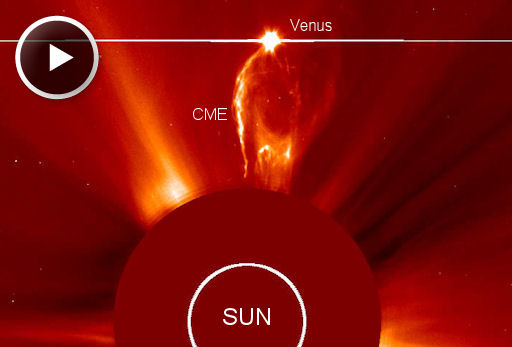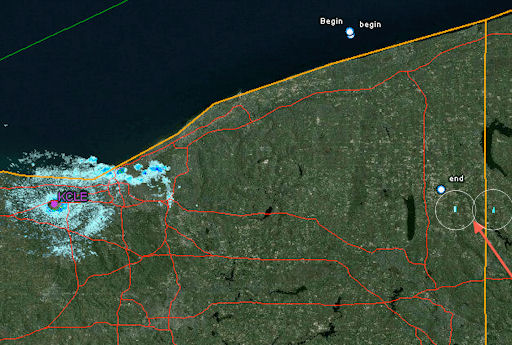Metallic photos of the sun by renowned photographer Greg Piepol bring together the best of art and science. Buy one or a whole set. They make a stellar gift. | | |
ACTIVE SUNSPOT: New sunspot 1272 on the sun's southeastern limb is crackling with C-class solar flares. Click here to view a specimen recorded by NASA's Solar Dynamics Observatory around 0200 UT on Aug. 17th. So far none of the blasts has been Earth-directed, although this could change in the days ahead as the active region turns to face our planet. Stay tuned.
VENUS AND THE SOLAR STORM: (Note: No planets were harmed in the production of this movie.) Yesterday, the Solar and Heliospheric Observatory witnessed a spectacular explosion on the sun that seemed to pass perilously close to Venus. Did the cloudy planet survive? Play the movie for answers:

Credit: Solar and Heliospheric Observatory, C2 coronagraph
As the movie shows, the CME passed harmlessly. There was no collision, and it wasn't even close. Although Venus seems to be near the sun, the planet is actually more than 100 million kilometers away. The two bodies are "in conjunction" this week as Venus moves almost directly behind the sun. Because of this arrangement, more CME-Venus conjunctions are possible in the days ahead. Check SOHO for the latest images.
METEORITE ALERT: Bill Cooke, head of NASA's Meteoroid Environment Office has issued a meteorite alert for residents of small towns east of Cleveland, Ohio. There could be space rocks on the ground waiting to be found. "On August 8 at 1:22 Eastern Daylight Time, all-sky cameras belonging to the Southern Ontario Meteor Network detected a fireball entering the atmosphere 54 miles above Lake Erie (80.944 W, 41.945 N), moving SSE at 25 km/s (55,900 mph). There is high confidence that this meteor produced meteorites." For one thing, the debris appears to have produced echoes from KCLE's doppler radar in Cleveland; note the circled reflections:

"The deep atmospheric penetration of this fireball combined with its deceleration and doppler radar echo strongly suggests a fall somewhere in the countryside east of Clevelend," continues Cooke. Pushpins in this Google map show some possible fall locations based on different assumptions about the meteorite's speed and mass. There could be debris anywhere in the countryside around the Ohio towns of Warren, Kinsman, and Hermitage. Readers who find a candidate meteorite are encouraged to contact the Meteoroid Environment Office for further instructions.
August 2011 Aurora Gallery
[previous Augusts: 2010, 2009, 2008, 2007, 2006, 2005, 2004, 2003, 2002]
2011 Noctilucent Cloud Gallery
[previous years: 2003, 2004, 2005, 2006, 2007, 2008, 2009]
Potentially Hazardous Asteroids (
PHAs) are space rocks larger than approximately 100m that can come closer to Earth than 0.05 AU. None of the known PHAs is on a collision course with our planet, although astronomers are finding
new ones all the time.
On August 17, 2011 there were 1241 potentially hazardous asteroids.
Notes: LD means "Lunar Distance." 1 LD = 384,401 km, the distance between Earth and the Moon. 1 LD also equals 0.00256 AU. MAG is the visual magnitude of the asteroid on the date of closest approach. | | The official U.S. government space weather bureau |
| | The first place to look for information about sundogs, pillars, rainbows and related phenomena. |
| | Researchers call it a "Hubble for the sun." SDO is the most advanced solar observatory ever. |
| | 3D views of the sun from NASA's Solar and Terrestrial Relations Observatory |
| | Realtime and archival images of the Sun from SOHO. |
| | from the NOAA Space Environment Center |
| | the underlying science of space weather |
| | for out-of-this-world printing and graphics |

